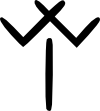
Latin "a"
Latin script and its variants are the most widely used writing systems in the world. Latin script is the primary writing system in most of Europe, almost all of North America, South America, Australia, and Antarctica, large portions of Africa, and a significant part of Asia. It has significant auxiliary use in Asia, e.g. as a second language and showing pronunciation for Chinese.
There is a Roman legend that the goddess Carmenta modified the Greek script to make the Latin script, but scholars believe that Latin script came from Etruscan script. Like Etruscan of the time, Latin was originally written right-to-left, but Latin eventually shifted to left-to-right. Latin jettisoned several Etruscan letters that were not needed, corresponding to the “ph”, “th”, and “kh”, and an “s” sound (roughly the Greek phi, theta, chi, and one not found in the modern Greek alphabet).
According to some Roman sources, Spurius Carvilius Ruga invented the “G” symbol to distinguish the “k” sound from the “g” sound, both of which had been written with a “C” (descended from the Greek “gamma”). He jettisoned the “z” (which was only used to write Greek loanwords), and put “G” in its place.
Later, after the Romans conquered Greece, they decided they writing Greek words was important after all. They grabbed the “Z” again; they also snagged the Greek “Y” (which in the variant the Etruscans had grabbed was shaped like a “V” and ended up being pronounced as “u”). The Romans stuck the “Y” and “Z” at the end of the alphabet (which is an extremely common place to put new letters).
Note that while Americans pronounce the letter “Z” as “zee”, almost all other English speakers (including Canadians) pronounce it as “zed” — like the Greek “zeta”.
The alert reader will note that I used capital letters (also called majuscule) for all the Latin script letters here, and that there is no mention of “W”, “J”, and “U”, which are not in the Greek alphabet. These are not typos. Early Latin only had what we think of as upper case letters, no spaces between words, and the “W”, “J”, and”U” did not exist in Latin at first. There was no “w” sound in Latin, “I” was also used for the “j” sound, and “V” was also used for “u”.
Early Latin did used vertically centered dots called interpuncts to separate words, but this went out of fashion even before the Romans did.
Note: I put that Latin Majescule originated in 690 BC, but really, we don’t know that precisely. We know that Etruscan and Latin both were around in the vicinity of 700 BC, and we know that Etruscan came first, but we don’t know exactly what date the first Etruscan words were written nor how long after that the first Latin words were written. It might have been six months between the two, it might have been fifty years.
Links: Wikipedia, Ancient Scripts, Omniglot








